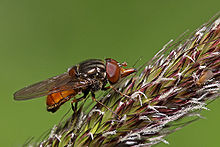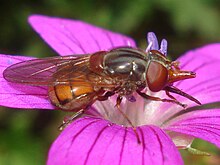Rhingia campestris
Appearance
| Rhingia campestris | |
|---|---|

| |
| male | |

| |
| female | |
| Scientific classification | |
| Kingdom: | |
| Phylum: | |
| Class: | |
| Order: | |
| Family: | |
| Genus: | |
| Species: | R. campestris
|
| Binomial name | |
| Rhingia campestris Meigen, 1822
| |
| Synonyms [1] | |
Rhingia campestris is a species of hoverfly, 7–11 millimetres (0.3–0.4 in) long, with a wingspan of 12–18 mm (0.5–0.7 in). It is common in many parts of Europe from March until November. It has a broad orange abdomen with a black line along the sides (the black line is absent along the sides of Rhingia rostrata), and has the distinctive long snout of all Rhingia species. Larvae are associated with cow dung. Adults males feed on nectar, while adult females feed on protein rich pollen, reflecting the cost of developing eggs.
